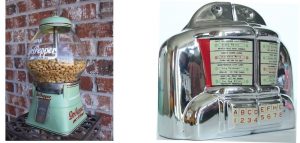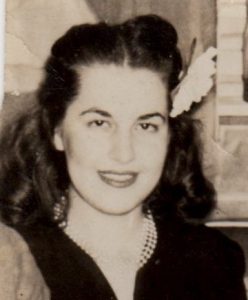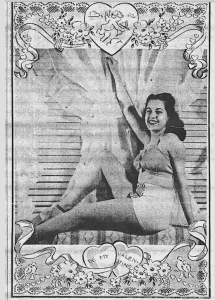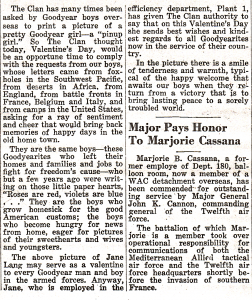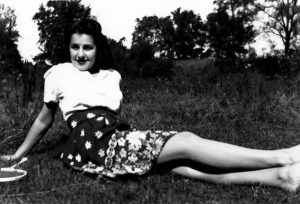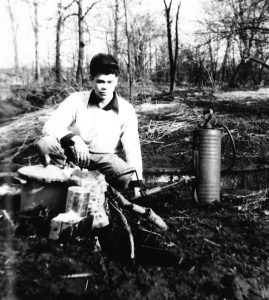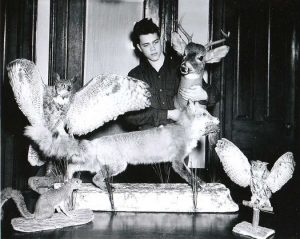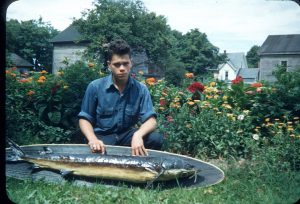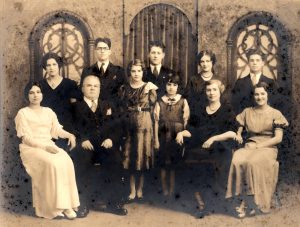
Lang Family picture taken on my mother’s wedding day
Seated L-R:Edith, Clem, Dolores, Jane, Trina, Irene
Standing L-R: Dorothy, Claude, Paul, Alice, Walter
Dec 26,1932
When my father lost his job with the Goodrich Company in Akron we moved in with Clem and Trina Lang, my maternal grandparents. We lived there from the time I was two years old until I was nine, 1935 to 1942. At this time Dolores and Jane Lang attended Randolph High School, Walter taught science at Randolph and later attended Western Reserve University. Paul was a mechanic at Jenior’s Ford Garage until he was killed in a motorcycle accident in 1938. Dorothy and Alice were married and did not live at home, Irene worked for a doctor in Akron and courted Leon May whom she later married. Claude ran the gas station and repaired electric motors, Edith (my mother) ran the post office which was in the front part of the store, and later taught 6th grade at Randolph School. The Lang family together with the Roliff family of four made for quite a large crowd under one roof.
The residence, general store and warehouse were in the same large building. The gas station was in a small building adjacent to the store. The living quarters consisted of a large kitchen, living room, and many large bedrooms and storage rooms upstairs.
The Kitchen
In the kitchen was a pantry, coal stove, gas stove, ice box, sink with counter, and a large table. There was no running water. A hand pump on the counter was piped to a cistern which was filled with run-off from the roof. This water was used for washing and cleaning. Drinking water was obtained from a well in the neighbor’s yard. A pail was filled from this well and placed on the kitchen counter where drinking and cooking water were dispensed with a long-handled dipper.
The icebox held the perishable food. The ice man would come with his horse-drawn cart, carry in a large block of ice on his leather-padded shoulder and drop it in the box. He would sometimes take his ice pick and make popsicles (icicles?) for the kids.
The coal stove had an open rectangular reservoir on one side which was filled with cistern water and heated for baths.
Baths were taken in a round galvanized tub filled with hot water from the stove reservoir. Clothes drying racks surrounded the tub with hanging clothes to provide some amount of privacy. This momentous event occurred maybe once a week.
The Living Room
In the living room (or sitting room) was the usual davenport and chairs along with a piano that played songs from a punched paper roll when pedals were pumped. There was a large steam radiator that went all the way around one corner. There were religious paintings hung on the walls. In those days when someone died, they were laid out in the living room. I remember both Uncle Paul and Grandpa in their caskets with neighbors coming in to pray and offer condolences.
Also this is where the Lang girls entertained boyfriends and did their “sparking”. With a crowd that large living under the same roof privacy was a rare commodity. I remember hiding in the doorway drapes during some of the sparking sessions to see if I could pick up any interesting conversation or useful techniques that I might be able to use at a later date.
The Outhouse
There was no indoor plumbing so we had an outhouse about 100 feet from the house. This was a deluxe version with 3 seats for grownups and a small seat for little people. It had plastered walls and curtains on the windows. There were newspapers and a Sears & Roebuck catalog for the paperwork or for reading, or both. I don’t know why there were so many seats. I can’t remember being in there with anyone but Mom. Slaked lime was used to cover up the “goodies” after every use. This also kept the flies and other critters away. There was hardly any offensive odor as in the port-a-potties one encounters nowadays at a ball game or rock concert.
I must say it was quite a thrill making the walk to the outhouse in the middle of the night during the winter.
The Cellar
The cellar was large and dark. It appeared to me that one could get lost down there forever. The joists overhead were logs, and the floor was dirt. In one corner was an old well that went out of service before I arrived on the scene. I was told that one of the pet dogs drowned in there.
There was a large black boiler taken from a steam locomotive that provided steam heat for the whole facility. It looked to me like a train had run into the house and got stuck in the cellar!
There was a separate room in the cellar with straw on the floor containing several cider barrels. I remember seeing old farmers sitting in there wearing knee boots, drinking cider while telling tall tales, jokes, and war stories.
In the fall all family members would gather in the cellar to make sauerkraut. Grandma Lang would shred the cabbage heads. The slaw was then put into 30 gallon crocks along with layers of salt. A round wooden float wrapped in cloth was then put on top with a gallon jug of water for a weight. Several months later sauerkraut was born.
Meals
There were 3 meals per day – breakfast, dinner and supper. If I recall correctly two of those meals nearly always had mashed potatoes, gravy, vegetable and some kind of meat.
Since the Langs were very strict Catholics, on Fridays the meat was replaced with something else. Fresh fish seemed almost impossible to obtain around Randolph before airlines and refrigeration. If you tried to cook the so-called “fresh fish” you had to leave the kitchen! On Friday salted cod that came in nice wooden boxes with dovetailed corners and sliding covers was used to make some kind of white gravy to serve with potatoes and green beans. I also remember having soup with canned oysters floating in white broth. It reminded me of mice floating around in milk. We ate this with little round soda crackers.
It was rough being a Catholic in those days!
Grandma Lang also made a sweet cake that she called “simmit kookel”. It was like a pizza, except it was rectangular and the topping was cinnamon, brown sugar and milk. She put dents in the dough with her fingers. Upon baking, these dents filled up with gooey sweet stuff. It was my favorite dessert.
Wash Day
Every Monday was wash day and every Tuesday was ironing day. There was a room off the kitchen called the wash room where the washing of clothes occurred. It contained an Easy Washer with a copper tub and a large agitator that was belt-driven from an electric motor. There was also a wringer with a crank that wrung the clothes which were then hung outside on a line or in the kitchen on drying racks. Grandma Lang spent most of the day every Monday washing clothes and the next day ironing them. She never had to worry about gaining weight.
The Warehouse Rats
Connected to the store was a large warehouse in which all kinds of parts, pulleys, belts, oil lamps, plow shares, animal feed, lard, grain, and other items of merchandise were stored. It was a treasure hunter’s dream. it was also the playground for huge rats. These were brown rats that were so large that the cats were afraid of them. They were also so smart that nobody could catch them in a trap – except for my dad.
Dad would take a plant flat, which is a wooden tray 3 feet square with 4 inch sides, fasten steel traps to the bottom, set and carefully cover the traps with chicken feed, making sure not to block the trigger mechanism. The rats would play in the feed at night and get caught, many times two or more at a time. Dad had to be careful when he killed the trapped rats not to get blood on anything or the wily rats would never come close to the box again.
Evidently Uncle Walter did not know anything about this trapping technique. One night he was absent-mindedly running his fingers through the chicken feed. Soon steel traps were hanging on both valuable hands of this future pediatrician.
At the time I was living there the store business was winding down but the gas station was still going strong. Later Mom told me that Grandpa Lang was very generous in handing out credit. He was used to dealing with the old farmers who always paid their bills on time. When the new and less honest element moved into town, they took advantage of Grandpa’s generosity and the business suffered. The store could no longer support the family the way it did in the old days.
In 1941 Dad bought the house next door. We didn’t have enough money to move there so he rented it out for a year. The following year we moved into our new house. I lived there until I was 22, at which time my friends and neighbors selected me to serve in the military.
I shall never forget the pleasant and exciting times I had living with the Lang family.
See related pictures here


